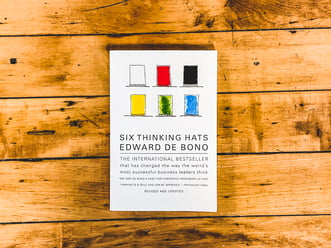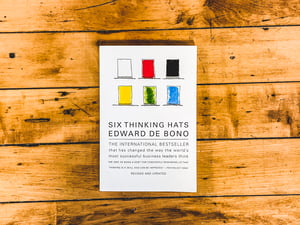 Editor’s Note: The Book Clubbin’ series recaps business and marketing related books read by the PR 20/20 team each quarter as part of the agency book club. This series will highlight key takeaways and top tips directly from each book club book.
Editor’s Note: The Book Clubbin’ series recaps business and marketing related books read by the PR 20/20 team each quarter as part of the agency book club. This series will highlight key takeaways and top tips directly from each book club book.
Thinking. It’s something we do on a daily basis. From deciding what you want in your coffee to preparing for a business call, thinking is required for almost every aspect of daily life.
But, how often are other people thinking the same way we are?
As marketers, it’s critical to have a strategic process in place to ensure your company is maximizing its efforts every single day.
To help amplify our thinking process, our team read Six Thinking Hats by Edward de Bono (@Dr_EdwarddeBono) for our most recent book club book. In de Bono’s book, he discusses a process that enables people to think from multiple perspectives by wearing a variety of different colored hats. The hats symbolize the following:
- White: Neutral and objective.
- Red: Emotion.
- Black: Somber and serious.
- Yellow: Sunny and positive.
- Green: Creativity.
- Blue: Control and organization.
Below, I break down how each hat plays a vital piece to the Six Thinking Hats process to help marketers improve their strategic thinking skills.
White Hat
The white hat is used twice during your brainstorm session: the beginning and end. When wearing the white hat, marketers should stay neutral and objective. Think about the facts and why something is the way it is.
Consider key information and data that support the foundation of your brainstorm. By doing this, you and your team will be able to define the details that are missing from the equation—without having personal preferences or biases affect the final result.
Additionally, fact check at the end of your session to ensure key ideas align with the original information at hand.
Red Hat
According to de Bono, “Using the red had gives you an opportunity to express feelings, emotions and intuition without any need to explain or justify them.”
Separating your emotions from your professional self can often be tricky. However, when wearing the red hat, you are provided with a unique chance to let your emotions come into play. Express emotions about whether or not you like an idea (i.e. “love it,” “like it,” or “don’t like it”).
Use your emotions to express how you personally feel about an idea and encourage others to do as well. Ensure all team members are giving some input, instead of opting to “pass” on their feelings.
Black Hat
The black hat is considered to be the most used, and potentially the most important. When wearing the black hat, marketers enable caution and a foundation for critical thinking. De Bono encourages you to ask the following:
- What is wrong?
- What doesn’t fit?
- What will not work?
Challenge yourself to play devil’s advocate to identify all solutions possible. While this hat may be the most essential, it’s critical to not overuse or abuse it. Being cautious is vital to the process, but being too cautious puts marketers at risk for siloed thinking. Use the black hat in moderation and when appropriate during your thinking process.
Yellow Hat
Positivity fuels the yellow hat. The book states that “Under the yellow hat a thinker deliberately sets out to find whatever benefit there may be in a suggestion.”
With the yellow hat, marketers are able to find the value in ideas and concepts. Look for the positives in all situations, even ones that may be more unattractive. While not all ideas will be an ideal fit for your brainstorm sessions, you may be able to discover other concepts from your original thoughts.
Additionally, while critical thinking is important, so is optimism. It’s vital to see both sides of the situation to properly assess the best outcome. Use the yellow hat logically to see the true value of each idea presented.
Green Hat
The green hat encourages growth and creativity. This part of the thinking process enables everyone to put their creative caps on, instead of solely relying on the go-to creative individual on your marketing team.
When wearing the green hat, look backwards at the situation, so you can evaluate the problem at hand and identify the possibilities. Understand what outcomes are possible to progress forward in your thinking process. The green hat is intended to deliberately push people forward towards the desired outcome.
Blue Hat
The blue hat is designed for brainstorming, and is typically worn by the facilitator, chairperson or leader of your brainstorm. Its purpose is to establish organization.
According to de Bono, “Blue hat thinking is not limited to organizing the use of the other hats. Blue hat thinking can also be used to organize other aspects of thinking such as the assessment of priorities or the listing of constraints.”
As a marketer wearing a blue hat, it’s your job to oversee the process and add commentary on observations made throughout. The blue hat provides guidance along the way to determine the outcome and progress made. From there, next steps can be made to conclude the brainstorm session.
Fuel knowledge through the power of reading.
Each quarter, the PR 20/20 team reads a business and/or marketing-related book to keep up with the latest industry trends and spark creativity. Check out our most recent posts from the Book Clubbin’ series to discover key takeaways from our selected books:
- How to Better Your Marketing with Empathy and Service
- How Marketers Can Incorporate Talk Triggers Into Their Marketing Strategies
- 4 Ways Marketers Can Better Manage Day-to-Day Activities
- 5 Tips to Bake Radical Candor Into Your Marketing Career
Be the first to know about the latest marketing news, tips and best practices. Subscribe to our blog today.

%20Logo_BlueOrange_Trademark.png?width=800&height=269&name=Ready%20North%20(RN)%20Logo_BlueOrange_Trademark.png)




.jpg?width=300&name=Services%20Hub%203%20(3).jpg)



COMMENTS